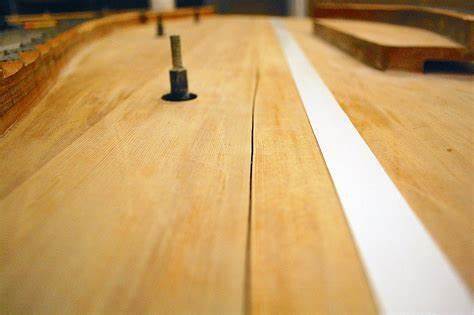
Your Soundboard is Cracked
Your technician has just announced he discovered a 1/4″ wide cracked soundboard. Do you panic? Has your precious instrument just become very expensive match sticks? Is there a remedy? Is the fix worse than the problem? There are at least 147 million questions that have been asked and at least that many answers and/or solutions proffered. It would be arrogant for me to postulate that I have THE answer to this age-old issue. What I will offer are some things to consider before jumping in with both feet. First, we need to consider the purpose of the soundboard. Then we will cover issues that may have caused the crack. Lastly, we will offer some hope to those have been sidelined by this malady.
What a Soundboard Does Best
The purpose of the soundboard in your piano is to couple the vibrations of the strings to the surrounding air, making the pitch of the string larger. It is extremely important to note that this process is NOT amplification. Amplification is the process of taking an electric signal and bosting its amplitude so as to make the resulting signal louder. The effect may be the same but the process is different. If a soundboard is too floppy, the resulting sound will likely be very loud but very short in duration. If the soundboard is too stiff, the resulting sound will likely sustain quite well but will have a nasal quality most people find objectionable. To find the “Goldie Locks” point is to manage the sound (tone) as the vibrations dance between the string and the soundboard, transmitted by the bridge from one to the other. (As an aside, the technical term is impedance.)
Is a cracked soundboard a problem? Will this ‘Grand Canyon’ of cracks inhibit a soundboard from doing its job? The answer takes a bit of woodworking knowledge, soundwave theory, and empirical evidence. Before we launch into these areas, it should be noted that some pianos never leave the factory due to cracks in the soundboard. It is a function of the environment of the instrument, in particular, the humidity levels and the structure of the wood. Even if the soundboards were x-rayed, it would be difficult to predict which ones would split.
Back to our question. A number of studies show that various frequencies provided by the strings are coupled to the surrounding air by different parts of the soundboard. Some will say they can predict these areas and therefore control the resulting sound. If this is true, then a crack through the middle of this area will, by definition cause a difference in the coupling process. Yet, in some cases empirical listening says that the tone is still pleasing.
Compression Set
A characteristic of wood known as compression set will also need to be considered. If you take a fairly new bentwood chair apart and leave it in the shop for a couple of days, the wood fibers will try to return to their ‘normal’ place causing the bent pieces of wood to straighten. If, however, a fairly old bentwood chair is disassembled, the bent pieces are much more likely to stay in their bent position. Over time, the wood fibers that are either in tension or under stress will ‘deform’ and become permanently disfigured in their new configuration. This disfigurement would indicate that the wood cells have lost some elasticity and elasticity is the very thing that makes a soundboard work in the first place. The problem in jumping to a diagnosis requiring major soundboard surgery is that in the crowned position, a soundboard may (MAY) continue to provide the proper impedance to produce a good quality tone. The cracked soundboard can contribute to a loss of frequency response, and/or it may engender a loss of impedance, or it may do none of the above, at least not at first.
Stay Tuned
It may seem a bit melodramatic or self-serving but to address a few of the possible solutions will take an article by itself. Please do not miss part 2 of Your Soundboard is Crack(ed).


